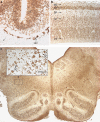Characterization of a t(5;8)(q31;q21) translocation in a patient with mental retardation and congenital heart disease: implications for involvement of RUNX1T1 in human brain and heart development
- PMID: 19172993
- PMCID: PMC2986559
- DOI: 10.1038/ejhg.2008.269
Characterization of a t(5;8)(q31;q21) translocation in a patient with mental retardation and congenital heart disease: implications for involvement of RUNX1T1 in human brain and heart development
Abstract
The chromosome break points of the t(8;21)(q21.3;q22.12) translocation associated with acute myeloid leukemia disrupt the RUNX1 gene (also known as AML1) and the RUNX1T1 gene (also known as CBFA2T3, MTG8 and ETO) and generate a RUNX1-RUNX1T1 fusion protein. Molecular characterization of the translocation break points in a t(5;8)(q32;q21.3) patient with mild-to-moderate mental retardation and congenital heart disease revealed that one of the break points was within the RUNX1T1 gene. Analysis of RUNX1T1 expression in human embryonic and fetal tissues suggests a role of RUNX1T1 in brain and heart development and support the notion that disruption of the RUNX1T1 gene is associated with the patient's phenotype.
Figures






References
-
- Erickson P, Gao J, Chang KS, et al. Identification of breakpoints in t(8;21) acute myelogenous leukemia and isolation of a fusion transcript, AML1/ETO, with similarity to Drosophila segmentation gene, runt. Blood. 1992;80:1825–1831. - PubMed
-
- Yamagata T, Maki K, Mitani K. Runx1/AML1 in normal and abnormal hematopoiesis. Int J Hematol. 2005;82:1–8. - PubMed
Publication types
MeSH terms
Substances
LinkOut - more resources
Full Text Sources
Medical

